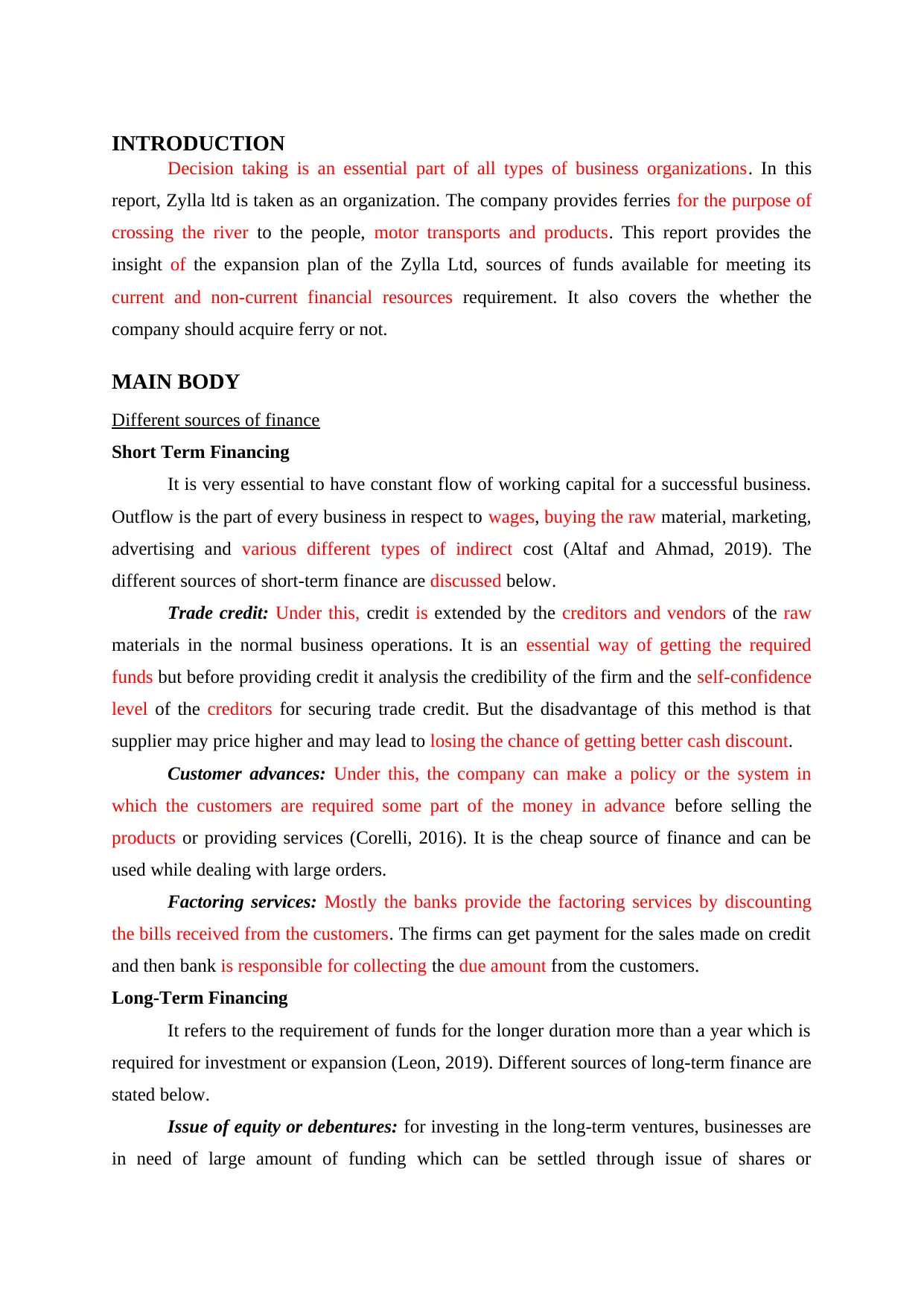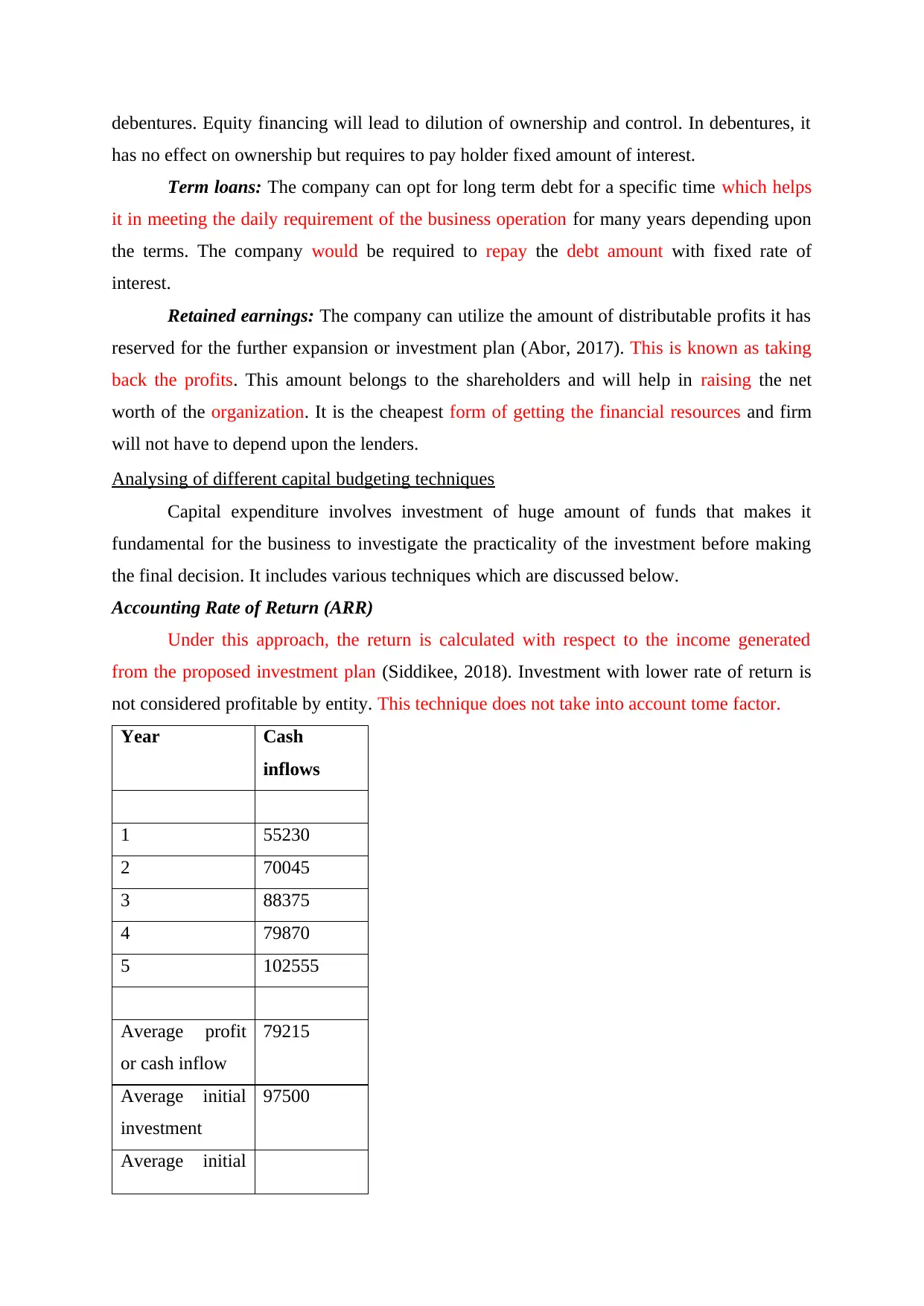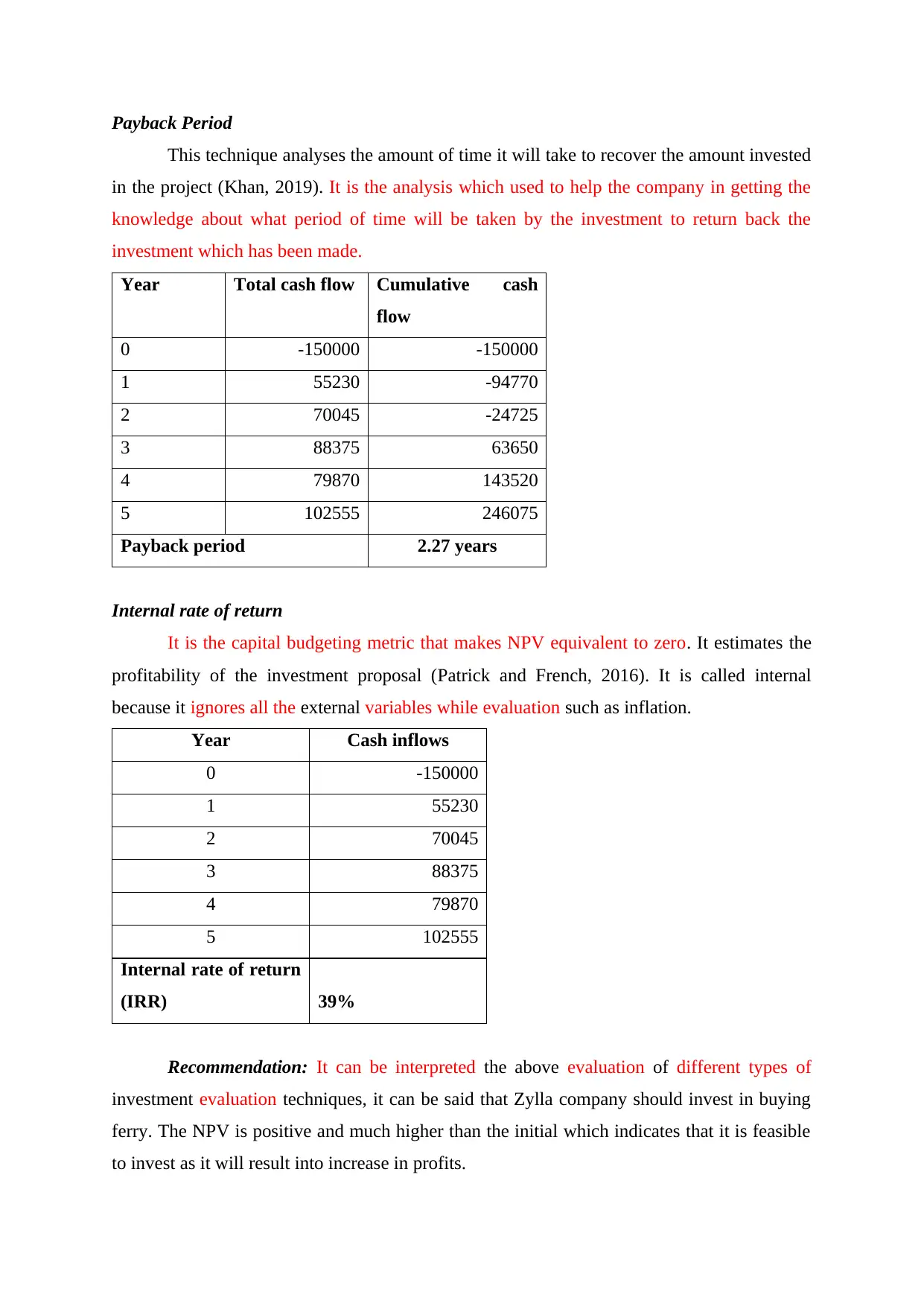Financial Analysis and Report: Zylla Ltd's Ferry Acquisition Plan
VerifiedAdded on 2023/01/11
|8
|1419
|54
Report
AI Summary
This report, prepared for Zylla Ltd, a company operating ferries, examines the financial implications of acquiring a new ferry to meet increased demand. The report details the sources of finance, both short-term (trade credit, customer advances, factoring services) and long-term (equity/debentures, term loans, retained earnings), available to fund the acquisition and expansion. It also analyzes various capital budgeting techniques, including Accounting Rate of Return (ARR), Net Present Value (NPV), Payback Period, and Internal Rate of Return (IRR), to assess the project's financial viability. Based on these analyses, the report recommends that Zylla Ltd invest in the ferry, concluding that the investment is financially sound and will increase profits. The report also includes a conclusion summarizing the key findings and recommendations, along with a list of cited references.

Business scenario for Individual
Report
Report
Paraphrase This Document
Need a fresh take? Get an instant paraphrase of this document with our AI Paraphraser


INTRODUCTION
Decision taking is an essential part of all types of business organizations. In this
report, Zylla ltd is taken as an organization. The company provides ferries for the purpose of
crossing the river to the people, motor transports and products. This report provides the
insight of the expansion plan of the Zylla Ltd, sources of funds available for meeting its
current and non-current financial resources requirement. It also covers the whether the
company should acquire ferry or not.
MAIN BODY
Different sources of finance
Short Term Financing
It is very essential to have constant flow of working capital for a successful business.
Outflow is the part of every business in respect to wages, buying the raw material, marketing,
advertising and various different types of indirect cost (Altaf and Ahmad, 2019). The
different sources of short-term finance are discussed below.
Trade credit: Under this, credit is extended by the creditors and vendors of the raw
materials in the normal business operations. It is an essential way of getting the required
funds but before providing credit it analysis the credibility of the firm and the self-confidence
level of the creditors for securing trade credit. But the disadvantage of this method is that
supplier may price higher and may lead to losing the chance of getting better cash discount.
Customer advances: Under this, the company can make a policy or the system in
which the customers are required some part of the money in advance before selling the
products or providing services (Corelli, 2016). It is the cheap source of finance and can be
used while dealing with large orders.
Factoring services: Mostly the banks provide the factoring services by discounting
the bills received from the customers. The firms can get payment for the sales made on credit
and then bank is responsible for collecting the due amount from the customers.
Long-Term Financing
It refers to the requirement of funds for the longer duration more than a year which is
required for investment or expansion (Leon, 2019). Different sources of long-term finance are
stated below.
Issue of equity or debentures: for investing in the long-term ventures, businesses are
in need of large amount of funding which can be settled through issue of shares or
Decision taking is an essential part of all types of business organizations. In this
report, Zylla ltd is taken as an organization. The company provides ferries for the purpose of
crossing the river to the people, motor transports and products. This report provides the
insight of the expansion plan of the Zylla Ltd, sources of funds available for meeting its
current and non-current financial resources requirement. It also covers the whether the
company should acquire ferry or not.
MAIN BODY
Different sources of finance
Short Term Financing
It is very essential to have constant flow of working capital for a successful business.
Outflow is the part of every business in respect to wages, buying the raw material, marketing,
advertising and various different types of indirect cost (Altaf and Ahmad, 2019). The
different sources of short-term finance are discussed below.
Trade credit: Under this, credit is extended by the creditors and vendors of the raw
materials in the normal business operations. It is an essential way of getting the required
funds but before providing credit it analysis the credibility of the firm and the self-confidence
level of the creditors for securing trade credit. But the disadvantage of this method is that
supplier may price higher and may lead to losing the chance of getting better cash discount.
Customer advances: Under this, the company can make a policy or the system in
which the customers are required some part of the money in advance before selling the
products or providing services (Corelli, 2016). It is the cheap source of finance and can be
used while dealing with large orders.
Factoring services: Mostly the banks provide the factoring services by discounting
the bills received from the customers. The firms can get payment for the sales made on credit
and then bank is responsible for collecting the due amount from the customers.
Long-Term Financing
It refers to the requirement of funds for the longer duration more than a year which is
required for investment or expansion (Leon, 2019). Different sources of long-term finance are
stated below.
Issue of equity or debentures: for investing in the long-term ventures, businesses are
in need of large amount of funding which can be settled through issue of shares or
⊘ This is a preview!⊘
Do you want full access?
Subscribe today to unlock all pages.

Trusted by 1+ million students worldwide

debentures. Equity financing will lead to dilution of ownership and control. In debentures, it
has no effect on ownership but requires to pay holder fixed amount of interest.
Term loans: The company can opt for long term debt for a specific time which helps
it in meeting the daily requirement of the business operation for many years depending upon
the terms. The company would be required to repay the debt amount with fixed rate of
interest.
Retained earnings: The company can utilize the amount of distributable profits it has
reserved for the further expansion or investment plan (Abor, 2017). This is known as taking
back the profits. This amount belongs to the shareholders and will help in raising the net
worth of the organization. It is the cheapest form of getting the financial resources and firm
will not have to depend upon the lenders.
Analysing of different capital budgeting techniques
Capital expenditure involves investment of huge amount of funds that makes it
fundamental for the business to investigate the practicality of the investment before making
the final decision. It includes various techniques which are discussed below.
Accounting Rate of Return (ARR)
Under this approach, the return is calculated with respect to the income generated
from the proposed investment plan (Siddikee, 2018). Investment with lower rate of return is
not considered profitable by entity. This technique does not take into account tome factor.
Year Cash
inflows
1 55230
2 70045
3 88375
4 79870
5 102555
Average profit
or cash inflow
79215
Average initial
investment
97500
Average initial
has no effect on ownership but requires to pay holder fixed amount of interest.
Term loans: The company can opt for long term debt for a specific time which helps
it in meeting the daily requirement of the business operation for many years depending upon
the terms. The company would be required to repay the debt amount with fixed rate of
interest.
Retained earnings: The company can utilize the amount of distributable profits it has
reserved for the further expansion or investment plan (Abor, 2017). This is known as taking
back the profits. This amount belongs to the shareholders and will help in raising the net
worth of the organization. It is the cheapest form of getting the financial resources and firm
will not have to depend upon the lenders.
Analysing of different capital budgeting techniques
Capital expenditure involves investment of huge amount of funds that makes it
fundamental for the business to investigate the practicality of the investment before making
the final decision. It includes various techniques which are discussed below.
Accounting Rate of Return (ARR)
Under this approach, the return is calculated with respect to the income generated
from the proposed investment plan (Siddikee, 2018). Investment with lower rate of return is
not considered profitable by entity. This technique does not take into account tome factor.
Year Cash
inflows
1 55230
2 70045
3 88375
4 79870
5 102555
Average profit
or cash inflow
79215
Average initial
investment
97500
Average initial
Paraphrase This Document
Need a fresh take? Get an instant paraphrase of this document with our AI Paraphraser

investment
[(initial
investment +
scrap value) / 2]
ARR 81%
Net Present Value
It indicates the profitability of the proposal by assessing the PV of future cash inflows
of the project (Roy, Rudra and Prasad, 2017). In case, if the NPV is positive then it is feasible
to invest. It considers time value of money. It derived by subtracting the present value (PV)
of cash outflow from the present value (PV) of cash inflow.
Year Cash inflows PV factor @
3%
Discounted
cash inflows
1 55230 0.971 53621
2 70045 0.943 66024
3 88375 0.915 80876
4 79870 0.888 70963
5 102555 0.863 88465
Total
discounted
cash inflow
359949
Initial
investment
150000
NPV (Total
discounted
cash
inflows -
initial
investment
)
209949
[(initial
investment +
scrap value) / 2]
ARR 81%
Net Present Value
It indicates the profitability of the proposal by assessing the PV of future cash inflows
of the project (Roy, Rudra and Prasad, 2017). In case, if the NPV is positive then it is feasible
to invest. It considers time value of money. It derived by subtracting the present value (PV)
of cash outflow from the present value (PV) of cash inflow.
Year Cash inflows PV factor @
3%
Discounted
cash inflows
1 55230 0.971 53621
2 70045 0.943 66024
3 88375 0.915 80876
4 79870 0.888 70963
5 102555 0.863 88465
Total
discounted
cash inflow
359949
Initial
investment
150000
NPV (Total
discounted
cash
inflows -
initial
investment
)
209949

Payback Period
This technique analyses the amount of time it will take to recover the amount invested
in the project (Khan, 2019). It is the analysis which used to help the company in getting the
knowledge about what period of time will be taken by the investment to return back the
investment which has been made.
Year Total cash flow Cumulative cash
flow
0 -150000 -150000
1 55230 -94770
2 70045 -24725
3 88375 63650
4 79870 143520
5 102555 246075
Payback period 2.27 years
Internal rate of return
It is the capital budgeting metric that makes NPV equivalent to zero. It estimates the
profitability of the investment proposal (Patrick and French, 2016). It is called internal
because it ignores all the external variables while evaluation such as inflation.
Year Cash inflows
0 -150000
1 55230
2 70045
3 88375
4 79870
5 102555
Internal rate of return
(IRR) 39%
Recommendation: It can be interpreted the above evaluation of different types of
investment evaluation techniques, it can be said that Zylla company should invest in buying
ferry. The NPV is positive and much higher than the initial which indicates that it is feasible
to invest as it will result into increase in profits.
This technique analyses the amount of time it will take to recover the amount invested
in the project (Khan, 2019). It is the analysis which used to help the company in getting the
knowledge about what period of time will be taken by the investment to return back the
investment which has been made.
Year Total cash flow Cumulative cash
flow
0 -150000 -150000
1 55230 -94770
2 70045 -24725
3 88375 63650
4 79870 143520
5 102555 246075
Payback period 2.27 years
Internal rate of return
It is the capital budgeting metric that makes NPV equivalent to zero. It estimates the
profitability of the investment proposal (Patrick and French, 2016). It is called internal
because it ignores all the external variables while evaluation such as inflation.
Year Cash inflows
0 -150000
1 55230
2 70045
3 88375
4 79870
5 102555
Internal rate of return
(IRR) 39%
Recommendation: It can be interpreted the above evaluation of different types of
investment evaluation techniques, it can be said that Zylla company should invest in buying
ferry. The NPV is positive and much higher than the initial which indicates that it is feasible
to invest as it will result into increase in profits.
⊘ This is a preview!⊘
Do you want full access?
Subscribe today to unlock all pages.

Trusted by 1+ million students worldwide

CONCLUSION
It can be summarised from the above that decisions related to making investment is
big thing and requires to calculate or look after various aspects. It involves identifying the
various sources of finance for executing the investment plan in both the aspect, that is, long
term and short term. Also, there are various techniques which can be used by the company for
evaluating the proposal for instance the payback period, NPV, internal rate of return (IRR)
and accounting rate of return (ARR). Thus, it can be concluded that Zylla ltd can consider
acquiring ferry as it will be a profitable business investment.
It can be summarised from the above that decisions related to making investment is
big thing and requires to calculate or look after various aspects. It involves identifying the
various sources of finance for executing the investment plan in both the aspect, that is, long
term and short term. Also, there are various techniques which can be used by the company for
evaluating the proposal for instance the payback period, NPV, internal rate of return (IRR)
and accounting rate of return (ARR). Thus, it can be concluded that Zylla ltd can consider
acquiring ferry as it will be a profitable business investment.
Paraphrase This Document
Need a fresh take? Get an instant paraphrase of this document with our AI Paraphraser

REFERENCES
Books and Journals
Abor, J. Y., 2017. Financing Choice. In Entrepreneurial Finance for MSMEs (pp. 359-369).
Palgrave Macmillan, Cham.
Altaf, N. and Ahmad, F., 2019. Working capital financing, firm performance and financial
constraints. International Journal of Managerial Finance.
Corelli, A., 2016. Financial Planning. In Analytical Corporate Finance (pp. 379-399).
Springer, Cham.
Khan, A., 2019. Evaluating Capital Projects and Budget Decisions. In Fundamentals of
Public Budgeting and Finance (pp. 319-359). Palgrave Macmillan, Cham.
Leon, F., 2019. Long-term finance and entrepreneurship. Economic Systems. 43(2). p.100690.
Patrick, M. and French, N., 2016. The internal rate of return (IRR): projections, benchmarks
and pitfalls. Journal of Property Investment & Finance.
Roy, D., Rudra, D. and Prasad, P., 2017. Capital Structure and Capital Budgeting: An
Empirical and Analytical Study of the Relationship. Research Bulletin. 42(4). pp.50-60.
Siddikee, M. J. A., 2018. The Development of the Green Capital Budgeting Approaches
Based on Traditional Capital Budgeting Approaches. International Journal of
Innovation and Applied Studies. 25(1). pp.253-262.
Books and Journals
Abor, J. Y., 2017. Financing Choice. In Entrepreneurial Finance for MSMEs (pp. 359-369).
Palgrave Macmillan, Cham.
Altaf, N. and Ahmad, F., 2019. Working capital financing, firm performance and financial
constraints. International Journal of Managerial Finance.
Corelli, A., 2016. Financial Planning. In Analytical Corporate Finance (pp. 379-399).
Springer, Cham.
Khan, A., 2019. Evaluating Capital Projects and Budget Decisions. In Fundamentals of
Public Budgeting and Finance (pp. 319-359). Palgrave Macmillan, Cham.
Leon, F., 2019. Long-term finance and entrepreneurship. Economic Systems. 43(2). p.100690.
Patrick, M. and French, N., 2016. The internal rate of return (IRR): projections, benchmarks
and pitfalls. Journal of Property Investment & Finance.
Roy, D., Rudra, D. and Prasad, P., 2017. Capital Structure and Capital Budgeting: An
Empirical and Analytical Study of the Relationship. Research Bulletin. 42(4). pp.50-60.
Siddikee, M. J. A., 2018. The Development of the Green Capital Budgeting Approaches
Based on Traditional Capital Budgeting Approaches. International Journal of
Innovation and Applied Studies. 25(1). pp.253-262.
1 out of 8
Related Documents
Your All-in-One AI-Powered Toolkit for Academic Success.
+13062052269
info@desklib.com
Available 24*7 on WhatsApp / Email
![[object Object]](/_next/static/media/star-bottom.7253800d.svg)
Unlock your academic potential
Copyright © 2020–2025 A2Z Services. All Rights Reserved. Developed and managed by ZUCOL.





